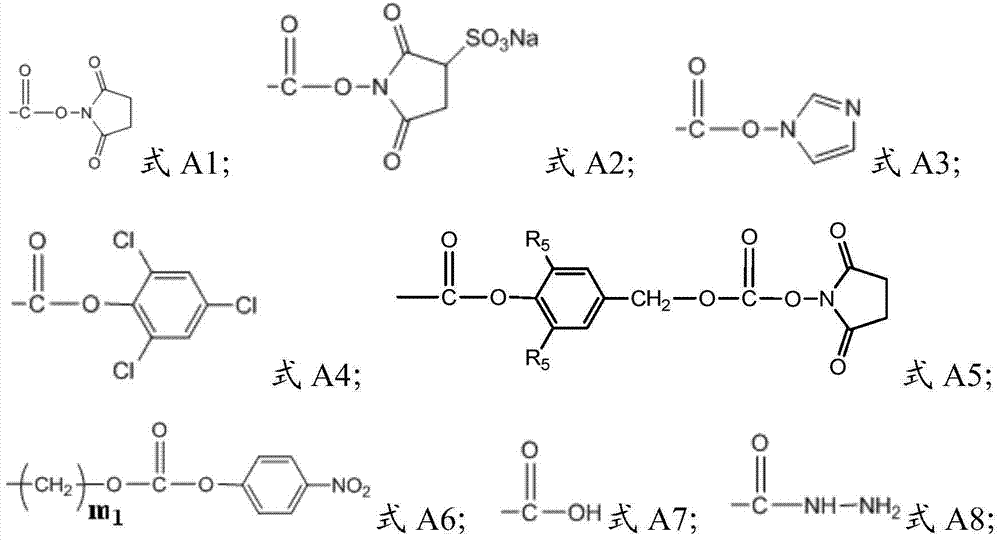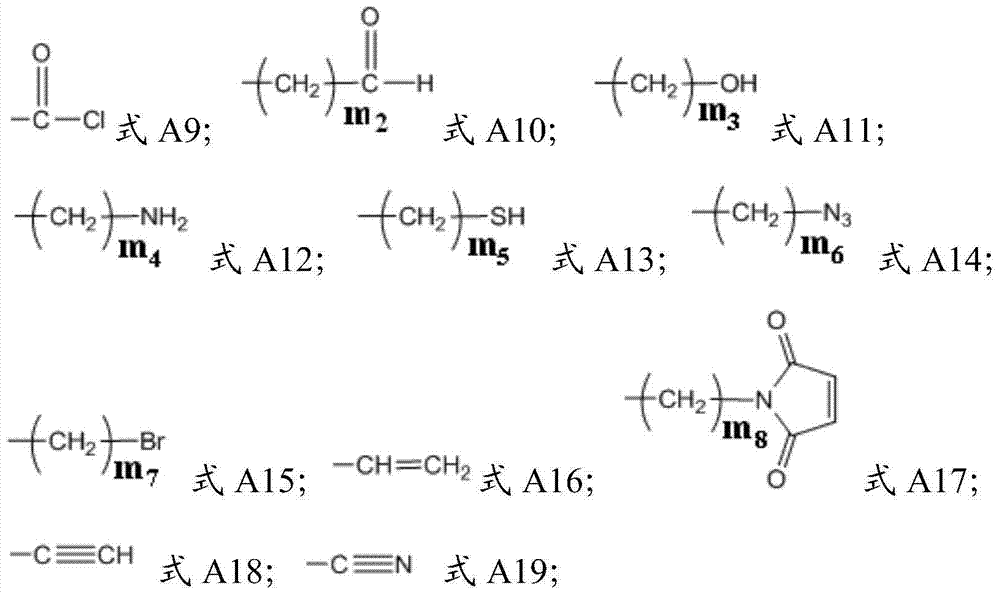Three-arm polyethylene glycol derivative and preparation method thereof
A technology of polyethylene glycol and derivatives, which is applied in pharmaceutical formulations, medical preparations without active ingredients, and medical preparations containing active ingredients, etc., can solve the problems of difficult separation and purification, complex product structure, etc., and achieve product structure. Simple, high modification rate, stable and repeatable effect
- Summary
- Abstract
- Description
- Claims
- Application Information
AI Technical Summary
Problems solved by technology
Method used
Image
Examples
preparation example Construction
[0093] n in formula B1 to formula B14 2 independently selected from 7-1000. In an embodiment of the present invention, n in formulas B1-B14 2 independently selected from 10 to 800; in other embodiments, n in formulas B1 to B14 2 independently selected from 50 to 500; in another embodiment, n in formulas B1 to B14 2 independently selected from 100-300. The invention provides a preparation method of a three-arm polyethylene glycol derivative, comprising:
[0094] Under the action of an initiator and a catalyst, the ring-opening polymerization of ethylene oxide is carried out to obtain a polymerized product;
[0095] Deprotonating the polymer product to obtain a first intermediate;
[0096] subjecting the first intermediate to end-capping treatment of branched chains to obtain a second intermediate;
[0097] modifying the W functional group in the second intermediate to obtain a three-arm polyethylene glycol derivative;
[0098] Described initiator has the structure shown ...
Embodiment 1
[0163] After adding 5g of pentaerythritol, 0.2g of p-toluenesulfonic acid and 100mL of toluene respectively in the round bottom flask, the round bottom flask was heated to 80°C, and 27mL of triethyl orthoacetate was added in the round bottom flask, Carry out the reaction of 24 hours; After the reaction finishes, remove the toluene wherein, obtain the first reaction product of 5.4g;
[0164] The first reaction product was dissolved in 20 mL of DMF, and 1.8 g of KHCO was added to the first reaction product 3 Carry out the reaction with 12.3g of 3-bromopropionic acid at 25°C for 2 hours, add 50mL of ethyl acetate and 20mL of distilled water to the resulting reaction solution for precipitation, and remove the solvent by rotary evaporation to obtain 3.8 the second reaction product of g;
[0165] The second reaction product was added to 20 mL of a mixed solution of isopropanol and water at a volume ratio of 3:1, and then 1 mL of an aqueous sulfuric acid solution with a molar concen...
Embodiment 2
[0172] The initiator was prepared according to the method described in Example 1. The difference from Example 1 was that 3-bromopropene was used to replace the 3-bromopropionic acid in Example 1.
[0173] The initiator prepared by the embodiment of the present invention 2 is carried out nuclear magnetic resonance test, and test result is:
[0174] 1 H NMR (400MHz, CDCl 3 )(δppm):
[0175] 5.78-5.86(=CH-), 5.14-5.25(=CH 2 ), 3.98(-CH2O-), 3.72(-OCH 2 -C),3.48(-CCH 2 -OH);
[0176] As can be seen from the above data, the initiator prepared in Example 2 of the present invention has a structure shown in formula E2:
[0177]
PUM
 Login to View More
Login to View More Abstract
Description
Claims
Application Information
 Login to View More
Login to View More - R&D
- Intellectual Property
- Life Sciences
- Materials
- Tech Scout
- Unparalleled Data Quality
- Higher Quality Content
- 60% Fewer Hallucinations
Browse by: Latest US Patents, China's latest patents, Technical Efficacy Thesaurus, Application Domain, Technology Topic, Popular Technical Reports.
© 2025 PatSnap. All rights reserved.Legal|Privacy policy|Modern Slavery Act Transparency Statement|Sitemap|About US| Contact US: help@patsnap.com



